As well as knowing some of the different certification programs for describing meat, it is important to know the terms for describing various types of market goats.
Newborn kids
Many goat dairies market excess kids shortly after birth. Markets may refer to them as “shoebox” kids because the ease of carrying them makes them popular as religious sacrifices in some cultures after the birth of a child. Kids from miniature breeds are older at the same size and hardier for this purpose. Kids receive colostrum the first day or two after birth and are then put on milk or milk replacer. Long hauls are hard on them and they are best delivered to nearby markets. As well as being marketed for religious sacrifice they are often purchased as pets or by feeder operations to hand raise on milk replacer.
Suckling kids
Terms for suckling kids include hothouse kids, Easter kids, cabrito (Mexico), capretto (Italy) and katsikia (Greece). They are unweaned kids ranging from about 4 to 12 weeks old. A good suckling kid is growthy and plump, looking like it has consumed lots of milk and little roughage. Dairy replacement kids or orphan kids raised on a minimum of milk and showing noticeable rumen development are not ideal. The meat should be relatively light in color.
Suckling kid
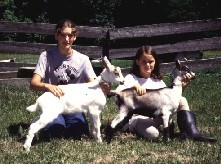
Dairy replacement
(on the right)
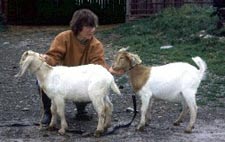
Orphaned kids
The cabrito and capretto markets ideally prefer kids 18 – 25 lbs live weight while Greek markets prefer kids 30 – 45 lbs. However, the hides-off rule (a federal requirement that carcasses must have the hide removed for retail sales) has increased the sizes required by many retail meat markets. Kids weighing 20 lbs or less dry out too fast when marketed with their hide off. Many suckling kids easily reach 45- 55 lbs by 12 weeks of age. Consumers from countries where goats are smaller may need to be reassured of their tenderness and youth. However, because customers are resistant to purchasing split carcasses, the high cost per lb live weight of suckling kids may work against marketing larger sucklings.
Market kids
Market kids are weaned kids with no adult teeth (all milk teeth). “Feeder” kids are very lean market kids in demand for feedlots. “Muslim kids” is a generic term for moderately lean market kids and refers to the preference of many ethnic customers for goats with no surplus fat. Heavier kids may be called “restaurant” or “finished” kids. “Yearlings” are young goats between one and two years old as judged by their teeth (one set of adult teeth generally indicated that a goat is between 1 and 2 years old).
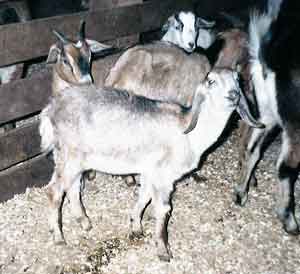
Feeder kids
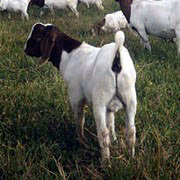
Lean market kids
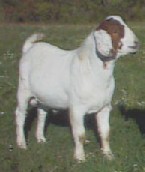
Finished kids
Wethers
Wethers are castrated male goats. Young castrated goats are popular with some cultures (Nepalese Hindus, etc.) while other cultures (Jamaican, etc.) prefer the manly flavor of intact (uncastrated) “ramgoats” or “billies”. However, it is important to be careful about generalizing about cultural preferences. Often people originating from the same country or religion have very different preferences. It is important to know your market. Adult wethers are in demand for medical research and antibody production.
Cull does
Young cull does are sometimes called “Philippino” goats. A plump young doe is desired but buyers are leery of any pouchiness hinting at possible pregnancy. Older cull does and bucks may be called “curry” or “African” goats because of their popularity for slow cooking into a stew or curry to feed a plentitude of people. The method of cooking them counteracts the toughness of older meat. However, excessively fat or boney goats are undesired. These “billies and “nannies” are also in demand to fill prison contracts. Keep in mind that well grown uncastrated market kids will sometimes be classified as smaller billies on market reports.
Market likes and dislikes
Some cultures have specific likes and dislikes when purchasing live slaughter goats. For examples, immigrants from some countries (Korea, etc.) prefer dark colored or black goats. These goats may have a medicinal or religious significance in their home country or they may find the appearance of a darker pigmented skin preferable on a scalded or singed carcass.
Buyers tend to shy away from Angora goats, pygmy goats and completely white goats. However, a meaty goat often overcomes these reservations. The goat meat market was initially worried about the large amount of white on Boer goats and potential for fat. Now most markets prefer goats showing Boer breeding. Goats with flashy markings or impressive horn sets may fetch extra money for sale to live animal markets. However, when making generalizations about what sort of goat a culture likes, keep in mind that any “culture” is made up of lots of subcultures and ultimately many diverse individuals and preferences.
Next
Module Home
Certification Table of Contents
Browsing Table of Contents
